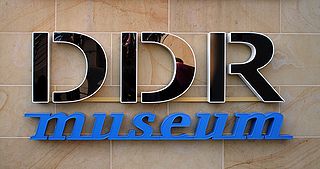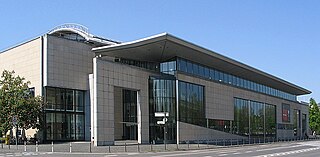
East Germany, officially the German Democratic Republic, was a country in Central Europe from its formation on 7 October 1949 until its reunification with West Germany on 3 October 1990. Until 1989, it was generally viewed as a communist state, and it described itself as a socialist "workers' and peasants' state". The economy of this country was centrally planned and state-owned. Although the GDR had to pay substantial war reparations to the Soviets, it became the most successful economy in the Eastern Bloc.

Günter Schabowski was an East German politician who served as an official of the Socialist Unity Party of Germany, the ruling party during most of the existence of the German Democratic Republic (GDR). Schabowski gained worldwide fame in November 1989 when he improvised a slightly mistaken answer to a press conference question about the future of the Berlin Wall. That raised popular expectations much more rapidly than the government planned and so massive crowds gathered the same night at the Wall, which forced its opening after 28 years. Soon afterward, the entire inner German border was opened.

The Palace of the Republic was a building in Berlin that hosted the Volkskammer, the parliament of East Germany, from 1976 to 1990.

The Peaceful Revolution, as a part of the Revolutions of 1989, was the process of sociopolitical change that led to the opening of East Germany's borders with the West, the end of the ruling of the Socialist Unity Party of Germany (SED) in the German Democratic Republic in 1989 and the transition to a parliamentary democracy, which later enabled the reunification of Germany in October 1990. This happened through non-violent initiatives and demonstrations. This period of change is referred to in German as Die Wende.

The German Historical Museum, known by the acronym DHM, is a museum in Berlin, Germany devoted to German history. It describes itself as a place of "enlightenment and understanding of the shared history of Germans and Europeans". It is often viewed as one of the most important museums in Berlin and is one of the most frequented. The museum is located in the 17th century Zeughaus (armory) on the Unter den Linden, just across the Spree from Museum Island. The museum's attached Exhibition Hall was designed by I. M. Pei in the late 20th Century.

Matthias Leupold is a German photographer and professor who lives and works in Berlin. His father Harry Leupold was set designer at the D.E.F.A. studio for feature films in Potsdam.

Markus Meckel is a German theologian and politician. He was the penultimate foreign minister of the GDR and a member of the German Bundestag.

The Checkpoint Charlie Museum is a private museum in Berlin. It is named after the famous crossing point on the Berlin Wall, and was created to document the so-called "best border security system in the world". On display are the photos and related documents of successful escape attempts from East Germany, together with the escape apparatus: hot-air balloons, getaway cars, chairlifts, and a mini-U-boat. The museum researches and maintains a list of deaths at the Berlin Wall. It is operated by the Mauermuseum-Betriebs gGmbH, and the director is Alexandra Hildebrandt.
Stefan Roloff is a German-American painter, video artist, filmmaker, and pioneer of digital video and photography, living and working in New York and Berlin. Roloff's documentary, The Red Orchestra, a portrait of his late father, Helmut Roloff, an anti-Nazi resistance fighter, was nominated for Best Foreign Film 2005 by the US Women Critics Circle.

The Tränenpalast is a former border crossing point between East and West Berlin, at Berlin Friedrichstraße station, which was in operation between 1962 and 1989. It is now a museum with exhibitions about Berlin during the Cold War period and about the process of German reunification. It was the border crossing for travellers on the S-bahn, U-bahn and trains going between East and West Germany. It was used only for westbound border crossings. It had separate checkpoints for West Berliners, West Germans, foreigners, diplomats, transit travellers and East Germans.

The DDR Museum is a museum in the centre of Berlin. The museum is located in the former governmental district of East Germany, right on the river Spree, opposite the Berlin Cathedral. The museum is the 11th most visited museum in Berlin.

Haus der Geschichte is a museum of contemporary history in Bonn, Germany. With around one million visitors every year, it is one of the most popular German museums. The Haus der Geschichte is part of the Haus der Geschichte der Bundesrepublik Deutschland Foundation, alongside the "Zeitgeschichtliches Forum Leipzig", the "Tränenpalast" at Berlin Friedrichstraße station and the "Museum in the Kulturbrauerei". The foundation's headquarters is in Bonn.

Wolfgang Templin – politician of the democratic opposition in Eastern Germany, publicist, concerned with the history of the GDR, the former Eastern Bloc and the German reunification.
Katrin Hattenhauer is a German painter and civil rights activist. In the late 1980s she was a member of the GDR-opposition movement. On 4 September 1989 she demonstrated "For an Open Country with Free People", marking the beginning of the Monday demonstrations in Leipzig. Her paintings and social sculptures have been exhibited in Europe.
The Museum in the Kulturbrauerei is a museum of contemporary German history. The permanent exhibition focuses on everyday life in the German Democratic Republic. It is located in the Kulturbrauerei building complex in Prenzlauer Berg district in Berlin, Germany.

Evelyn Richter was a German art photographer known primarily for social documentary photography work in East Germany. She is notable for her black & white photography in which she documented working-class life, and which often showed influences of Dadaism and futurism. Her photography is focused on people in everyday life, including children, workers, artists and musicians.
Henrike Naumann is a German installation artist.

The Capa House is a building in the Lindenau quarter of Leipzig, Germany at Jahnallee 61. It is named after the American war reporter and photographer Robert Capa, and is the location where Capa took The Picture of the Last Man to Die of the United States army soldier Raymond J. Bowman, who was killed there two weeks before the end of the Second World War in Europe. The images became internationally known when they were published in Life magazine.

The Step of the Century is a bronze sculpture that was created by Wolfgang Mattheuer in 1984. It is considered one of the most important works of art in the GDR at the time of the division of Germany and is a parable of the turmoil of the 20th century.
















